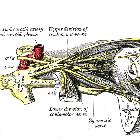Trigeminal ganglion



The trigeminal ganglion, also known as the Gasser, Gasserian or semilunar ganglion, is the large crescent-shaped sensory ganglion of the trigeminal nerve located in the trigeminal cave (Meckel cave) surrounded by cerebrospinal fluid.
The ganglion contains the cell bodies of the sensory root of the trigeminal nerve. From the ganglion, the 3 major divisions of the trigeminal nerve emerge anteriorly and inferiorly, with the first two (ophthalmic and maxillary divisions) passing anteriorly to enter the cavernous sinus, and the third (mandibular division) descending into the foramen ovale.
Relations
- medial: motor root of the trigeminal nerve and sphenoid bone
- lateral: posterior part of the cavernous sinus, petrous apex and petrous segment of the internal carotid artery
- anterior: cavernous sinus and cavernous segment of the ICA
- posterior: prepontine cistern
- inferior: greater petrosal nerve and middle cranial fossa
Blood supply
- small ganglionic branches of the cavernous portion of the ICA
- accessory meningeal artery (from the maxillary artery, via the foramen ovale)
Innervation
The ganglionic epineurium is innervated by the nervus spinosus from the mandibular division of the trigeminal nerve which re-enters the skull via the foramen spinosum.
Siehe auch:
und weiter:

 Assoziationen und Differentialdiagnosen zu Ganglion Gasseri:
Assoziationen und Differentialdiagnosen zu Ganglion Gasseri: